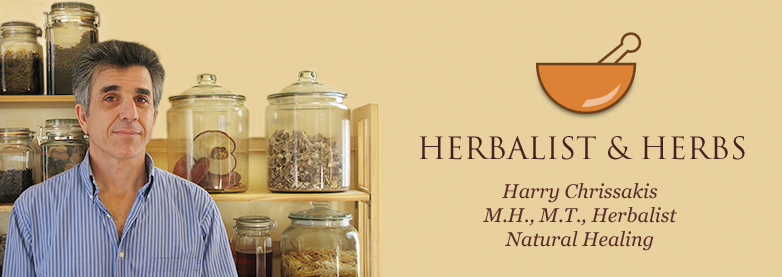by Harry Chrissakis Herbalist M.H. M.T. Natural Healing
HERBALIST AND HERBS
The combination of traditional use and modern scientific research on plant medicines has opened doors to treatment possibilities on disorders such as cancer. Although traditional systems historically have treated cancer with herbs successfully, modern cancers are more complex and many practitioners fail using only traditional methodology. Many practitioners of natural medicine do what I call clean up. That is they deal with the fallout of chemo and radiation only, and even then it is hit and miss. To say an herb is good for cancer is insufficient, even with historical precedence. Now we can get specific and really go after areas in a very definite way with definite results with plant medicines.
What I would like to show is that due to modern research and applied technology, we can take a simple herb like Milk Thistle and fit it into a cancer protocol where it becomes a player in creating positive change.
Herbs tend to get marginalized into specific applications relative to the trend of that period. Milk thistle, in traditional American herbal medicine (Eclectic and Physio-Medical) was used as a spleen tonic in the 1800s.
In contemporary Western Herbalism it is used almost exclusively as a liver herb. The tendency is to bury the herb into the slot and forget about it. This is one reason why it is critical for practitioners to continue with their study; like forever. There are brilliant people out there doing amazing things; reproduceable, teachable amazing things in the field of plant pharmacology and cancer research. These folks are opening new doors of application never imagined.
Let’s look at milk thistle in a cancer protocol.
Inflammation is one of the hallmarks of cancer. It cannot really go far without it. That is why the cancer is doing its best to maintain an inflammatory environment. Two primary pathways for inflammation are NF-kb and Cox 2 pathways. These gatekeepers open up the doors for 3 to 4 other inflammatory pathways, which in turn open up lots of other undesirable things in the cancer patient. Milk Thistle directly modulates NF-kb and Cox 2, helping to normalize both. This is no small thing. In standard practice oncology, the drug Celebrex is used as a Cox 2 inhibitor. Celebrex has lots of down sides.
Speed of replication is a definite problem in cancer cell pathology (dividing way too fast) Equal to that problem is the fact that cancer cells do not die normally (apoptosis). The cancer cell selectively mutates out the built in process that down regulates a normal cell at the end of its life. Cancer cells live unnaturally long lives if allowed to and can endlessly divide and produce new and stronger mutations. Maintaining apoptosis is crucial to maintaining normal cell population numbers. Milk Thistle helps maintain the process of apoptosis in Cancer cells.
Angiogenesis is the process of growing new blood vessels and in a normal setting, applied to wound healing. Cancer takes over this process to serve its own ends. A cancer tumor will need to increase its supply of sugar and oxygen very early in its evolution. Angiogenesis creates the infrastructure for that to happen through the process of growing new blood vessels for the cancer cell. EGFR, VEGF and IGFR 1 are major growth factors in this process. Milk Thistle balances and normalizes all 3. I use the terms balance and normalize in relation to natural medicine, because the intent is very different than standard practice oncology. Drugs wipe out or strongly suppress a process and this definitely has a place in cancer therapy. Natural Medicine modulates it in an attempt to normalize function and maintain these critically important processes which we need to stay healthy.
Cell division has four parts to it. The process is called cell cycling. P21 and P27 are genes that help control cell cycling. Cancer often damages and mutates these gene sites. At that point, instead of helping to control cancer (Tumor Suppressor Genes), these damaged genes encourage it (Oncogenes). Milk thistle promotes proper function of these gene sites by protecting them from oxidation. Other important areas that Milk Thistle helps balance and normalize in a cancer profile are INos, HIF1, mTOR, and STAT 3. Milk Thistle also raises glutathione levels in the liver. Glutathione is our primary endogenous cellular antioxidant. The Glutathione pathway in the Liver ( Phase 2) is one of the pathways that gives the liver its ability to detoxify harmful substances and glutathione is in and of itself protective to the Liver as well.
I could keep going with this, as Milk Thistle (and many other herbs) have broad effect and application. At this point it is important to talk about which Milk Thistle I mean. The Milk Thistle I am referring to is standardized to 80% Silymarin (there are 3 forms of Silymarin in Milk Thistle) at a 30:1(or higher ) concentration. Dosages are relatively high and are often combined with other herbs of a similar nature. Alteration of plants through a variety of means is nothing new ( i.e 30:1 extract) Chinese, Ayurvedic and Tibetan medicine have been doing this for centuries. The idea of a pure herbal medicine is questionable. A science, no matter what it is, needs to remain in a state of evolution. The idea of using substances that are non-toxic, non addictive, are relatively inexpensive and that actually work to create positive change in the cancer patient is a great idea.
Harry Chrissakis
Herbalist, M.H.,M.T. Natural Medicine
www.HerbalistandHerbs.com
530-933-8244
